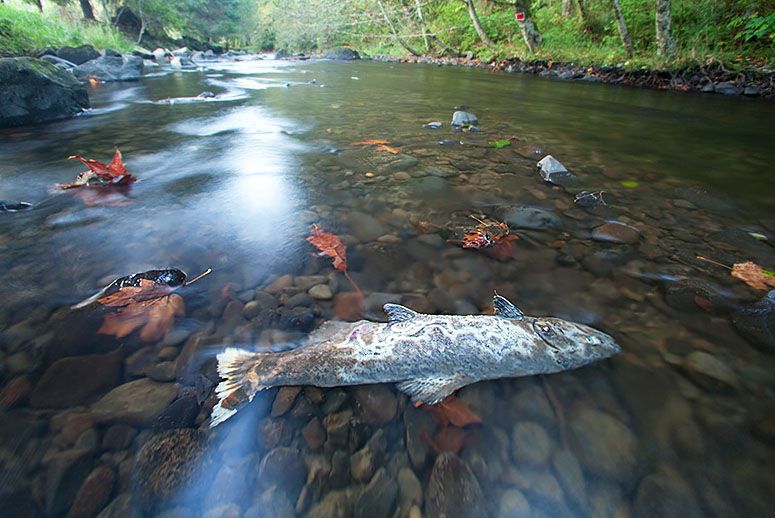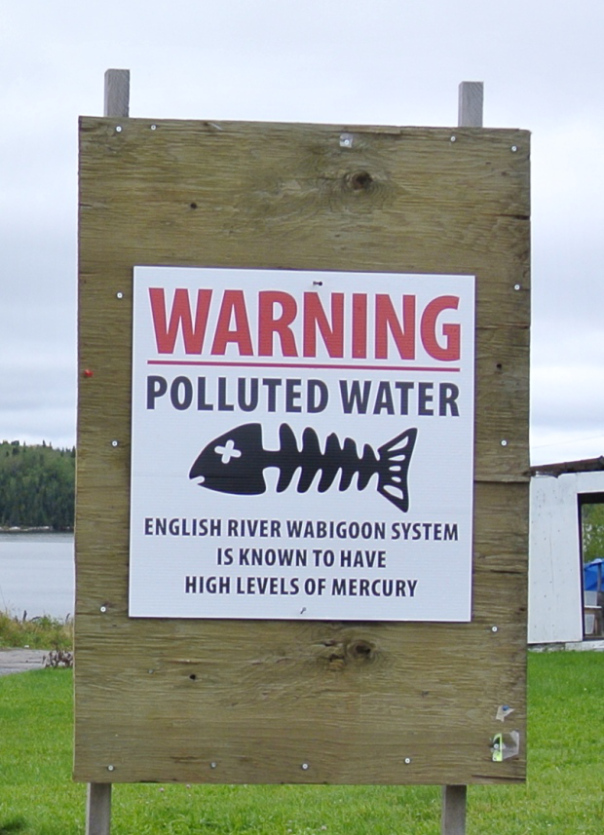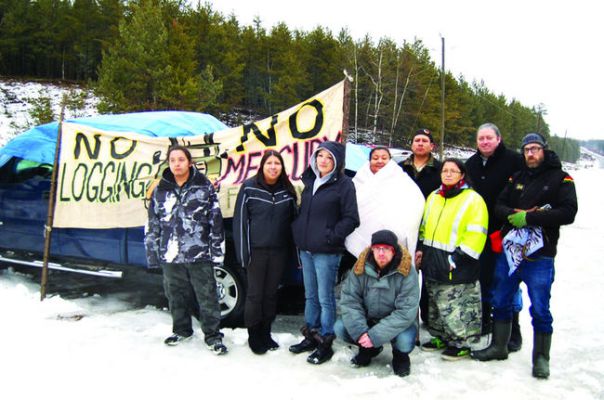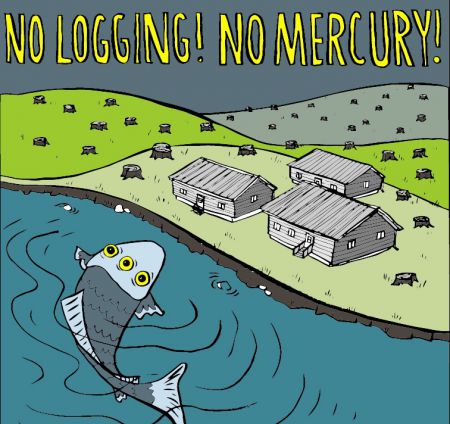Grassy Narrows
Ontario, Canada
Justin King
A Brief History
The community of Grassy Narrows is a prime example of environmental injustice. Like many other native communities, Grassy Narrows, located in Northwestern Ontario, has suffered
from colonialist ideals and has lost several cultural aspects as a result. At the beginning of the 1960s, Grassy Narrows resided on ancestral land that had been allocated to them by the North-West Angle Treaty of 1873.

River of Poison

Before discussing the effects that river pollution has had on Grassy Narrows, it is first important to mention how the river became polluted in the first place. This small community of about 1490 people lies along the English-Wabigoon river system. This river had historically provided them with a majority of their sustenance, that being fish, but as the river became polluted, the population of fish became poisonous. Between 1962 and 1970, Dryden Chemicals Limited, a pulp and paper mill located about eighty miles upstream from Grassy Narrows, dumped over 20,000 pounds of mercury into the river as effluent from its chlor-alkali plant. (Shkilnyk, 179) In 1970, the Ontario Minister of Energy and Resource Management ordered Dryden Chemicals to stop dumping mercury into the environment, but by that time, the damage had already been done. With the discovery of mercury in the river happening only a few years after the second relocation, the effects were all the more devastating. With fish being a major source of food for the community, and mercury pollution being physically invisible, Grassy Narrows was unaware that their food was poisonous. Fishing for food was common among individuals as well as among commercial operations. The community not only relied on the fish for food, but also for economic advancement, however, in 1970 after the discovery of mercury, the community was forced to stop fishing for commercial and tourist purposes. (Ilyniak, 45) Signs were put up along the river that said "Fish for Fun" with an illustration of a skull and crossbones underneath. (Rodgers et al.,2009) The pollution of the river affected the community in more than one way. Along with the loss of food supplies and economic opportunities, the poisonous fish that were caught and used for food prior to the 1970 order were nonetheless consumed, and the health of the community suffered.
Prior to 1970, the most important use of mercury was in chlor-alkali plants that served the pulp and paper industry. The industry was known for losing great volumes of mercury in wastewater and exhausted gasses, however, the effects that mercury had on the environment and on humans was not documented until the epidemic of mercury poisoning in Minamata, Japan. (Shkilnyk, 182-83)
Minamata was a fishing village of about 40,000 people and it is associated with Minamata disease because by 1970, 107 lives had been taken as a result of mercury poisoning and thousands more had suffered from neurological damage, crippled limbs, blindness, and other physical ailments. As symptoms emerged within the community of Grassy Narrows, a lot of confusion resulted due to the population not having any sort of education on the disease and what levels of mercury could be acceptable, vs. what levels of mercury would harm an individual. Therefore, medical experts headed to Grassy Narrows to not only educate the community, but also to run tests on individual levels of mercury found in one's blood or hair. A more recent operation took place in 2014, when Dr. Masanori Hanada headed a team of experts from Japan to test mercury levels at Grassy Narrows. Since the 1970s, Japanese doctors and experts have traveled all around the world to assist communities suffering from mercury poisoning. They have the knowledge and expertise due to their extensive experience with Minamata disease on a local level. When the report was released, Hanada concluded that the community is indeed suffering from mercury poisoning, and some individuals were even under the age of 30. (Nahwegahbow, 2016) "We found that more than 90 percent of the population in these communities have sensory disturbance" (Nahwegahbow, 2016) which is one of the first symptoms of mercury poisoning. Compared to governmental statements that brush aside the possibility of Minamata disease, Dr Hanada states that his team has the knowledge to identify Minamata disease, and Grassy Narrows most definitely suffers from it. So what has been done? Since 1970, the levels of mercury in the environment has gone down, but that doesn't mean the effects aren't still felt. Mercury poisoning slowly deteriorates the brain so individuals are still suffering from it. The Canadian government continues to deny the possibility of Minamata disease, but accepts that Grassy Narrows is poisoned, so how does that make sense? It doesn't. Executives of Dryden Chemicals and Reed Paper Limited have repeatedly stated how mercury occurs naturally in the environment and that the burden of mercury poisoning at Grassy Narrows shouldn't fall on their shoulders. But, the effects of mercury poisoning were noticed shortly after the company dumped 20,000 pounds of it into the river. Other excuses revolved around how the mercury discharged in the Wabigoon system was less harmful than the mercury discharged at Minamata and therefore didn't require an emergency level of response. Company officials continued to deny their responsibility for the environmental disaster, saying that mercury pollution was a societal responsibility and that any questions or concerns should be taken to court. (Shkilnyk, 191)

Clearcutting and Activism
The Grassy Narrows reserve sits on 36.25 square kilometers within a 6,475 square kilometer area of traditional land use. (Rodgers et al., 2009) In 1873, a treaty was established between Grassy Narrows and the Canadian government that stated, "Indians shall have the right to pursue their avocations of hunting and fishing throughout the tract surrendered...saving and excepting such tracts as may, from time to time, be required or taken up for settlement, mining lumbering or other purposes" (Rodgers et al., 2009). This treaty was problematic because if you looked at it in a legalistic manner, it basically allowed the government to do whatever it wanted when it came to alloted land. Historically, the town of Kenora had been a logging town. The company, AbitibiBowater, which until recently had supplied newsprint for hundreds of newspapers, including the New York Times, conducted logging operations on native trap-lines as well as within the Whiskey Jack Forest which happens to overlay the traditional land alloted to Grassy Narrows. In fact, three quarters of the forest lies on native land, but AbitibiBowater has barely paid any attention to native concerns. (Willow, 91) It was said that about 70 percent of the community's traditional trap-lines had been clear-cut by the early 2000s, and AbitibiBowater didn't show any signs of stopping regardless of native concern because the company had proposed a clear-cutting plan up until 2019. (Willow, 93) This plan was met with numerous protests and demands for stronger regulation and/or environmental assessments, however, trying to solve the issue through the legal system resulted in counter productivity. In all legal parameters, the company had the right to clearcut traditional, native land under the treaty set in 1873, so the community of Grassy Narrows took matters into their own hands and prevented further logging operations within the traditional area of Whiskey Jack Forest. "A blockade, it seemed, was the only way to get their point across" (Willow, 102). In December of 2002, community members erected a blockade at Slant Lake, which is located five miles north of Grassy Narrows. The community anticipated a lengthy struggle, but were determined to prevent their land from being destroyed. The blockade became a sort of community center and a base camp was set up, with an everlasting sacred fire that was tended to regularly. Blockaders managed to keep a twenty four hour a day presence at the site and by mid-December, between ten and thirty people were constantly camped at the blockade. High school teachers started holding classes at the blockade which was met with favorable response from the school principle because it gave the students an opportunity to learn of their treaty rights, as well as gave the adults a sense of pride in the younger generations. (Willow, 105)

What Now?
Despite these environmental hardships, Grassy Narrows remains resilient in their resistance. Judy da Silva is referenced in an article by Natalia Ilyniak and she said, "It's not just about like kicking the loggers out or just protecting the water from pollution, but it's about protecting our life as a nation, as Anishinabek, because our identity comes from there. For thousands of years we've been here, since like time started and that's what we want to pass onto our children" (Ilyniak, 60). With having this mindset, the next generation can be more prepared for any further injustices and can have the knowledge and tools to address decolonization. Like many other indigenous communities in North America, Grassy Narrows has faced a pattern of hardships that revolve around colonialist ideals. Their voices have been ignored within the legal system so activism and resistance has been their last resort. In their resistance movements, Grassy Narrows has been successful in raising public awareness which has resulted in media attention and assistance from non-natives. Since 2008, Grassy Narrows has led peaceful walks that are meant to draw attention to indigenous issues as another way of making their voices heard. "From marches, to solidarity actions, to physically standing in the way of capitalist and colonial encroachment on their territory, to living in line with traditional ways of life, Grassy Narrows certainly has a strong culture of resistance" (Ilyniak, 61).

References
Ilyniak, Natalia. 2014. "Mercury Poisoning in Grassy Narrows: Environmental Injustice, Colonialism, and Capitalist Expansion in Canada." McGill Sociological Review 4: 43-66. ProQuest,https://search-proquest-com.proxy2.cl.msu.edu/docview/1963078041/fulltextPDF/E7BEC05482CF461EPQ/1?accountid=12598. Web. 10 Feb 2018.
Nahwegahbow, Barb. 2016. "Grassy Narrows: young people are scared: they know they're sick." Windspeaker, 15 Oct. 2016, p. 7. Academic OneFile, http://link.galegroup.com/apps/doc/A472474193/AONE?u=msu_main&sid=AONE&xid=e8b2d32d. Web. 10 Feb. 2018.
Rodgers, Bob and Ivy Keewatin. 2009. "Return to Grassy Narrows: A poisoned community tells its 40-year old story." Literary Review of Canada, vol. 17, no. 1, p. 22+. Academic OneFile, http://link.galegroup.com/apps/doc/A243527981/AONE?u=msu_main&sid=AONE&xid=245f482b. Web. 10 Feb. 2018.
Shkilnyk, Anastasia M. 1985. A Poison Stronger Than Love. New Haven: Yale University Press.
Willow, Anna J. 2012. Strong Hearts, Native Lands: The Cultural and Political Landscape of Anishinaabe Anti-Clearcutting Activism. Albany: State University of New York Press.
Images
Adrangi, Maryam. 2014. "Grassy Narrows First Nation Demands Ontario Halt Clear-Cut Logging On Their Lands." Toronto Media Co-op, http://toronto.mediacoop.ca/fr/story/grassy-narrows-first-nation-demands-ontario-halt-c/31254. Web. 14 April 2018.
Ferguson, Rob. 2016. "Ontario Should Take Action on Grassy Narrows: Editorial." The Star, https://www.thestar.com/opinion/editorials/2016/06/03/ontario-should-take-action-on-grassy-narrows-editorial.html. Web. 14 April 2018.
Hill, Taylor. 2015. "Coho Salmon Are Choking to Death on Urban Pollution - but There's a Fix." Take Part, http://www.takepart.com/article/2015/10/10/salmon-urban-runoff-fix. Web. 14 April 2018.
Porter, Jody. 2017. "Report Suggesting Mercury Still Leaking Near Grassy Narrows 'Deeply Concerning,' Chief says." CBC, http://www.cbc.ca/news/politics/grassy-narrows-old-mercury-report-1.4001775. Web. 14 April 2018.
Zig Zag. 2014. "Grassy Narrows: Why is Japan Still Studying the Mercury Poisoning when Canada Isn't?" Warrior Publications, https://warriorpublications.wordpress.com/tag/grassy-narrows-mercury-poisoning/. Web. 14 April 2018.